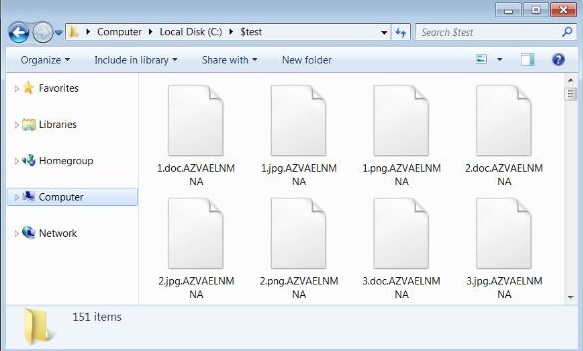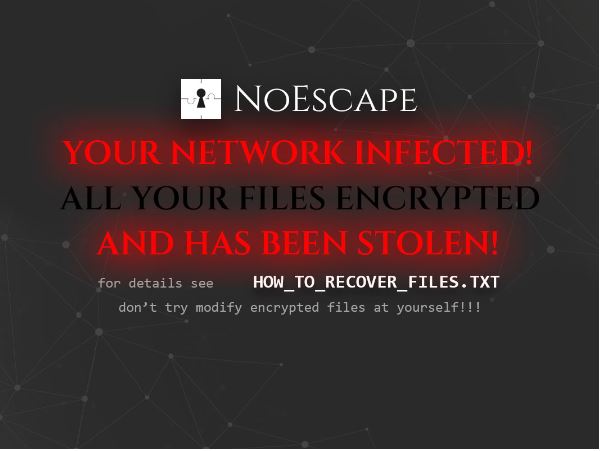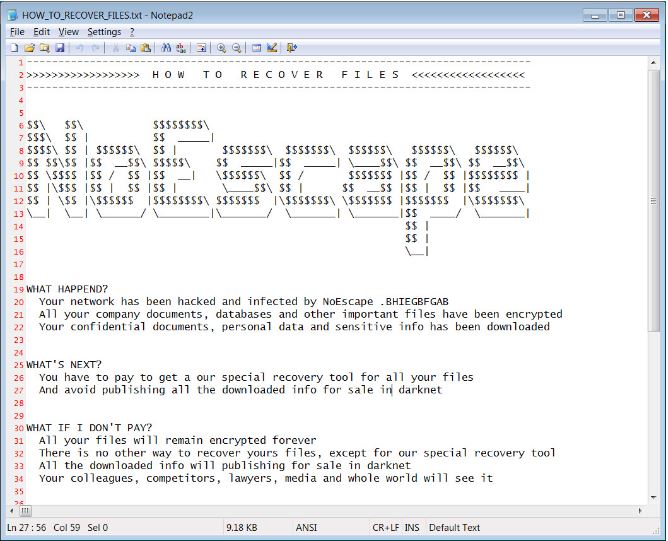NoEscape Ransomware
Original Issue Date:-
October 06, 2023
Virus Type:- Ransomware
Severity:-
Medium
It has been reported that recently emerged NoEscape ransomware, which is believed to be a rebrand ofAvaddon is targeting the enterprises in double-extortion attacks. As part of these attacks, the threatactors steal data and encrypt files on Windows, Linux, and VMware ESXi servers.
Infection Mechanism
Upon execution, NoEscape ransomware will run the following commands to delete Windows ShadowVolume Copies, local Windows backup catalogs, and to turn off Windows automatic repair:
- SHADOWCOPY DELETE /nointeractive
- wmic SHADOWCOPY DELETE /nointeractive
- wbadmin DELETE SYSTEMSTATEBACKUP -deleteOldest
- wbadmin DELETE BACKUP -deleteOldest
- wbadmin DELETE BACKUP -keepVersions:0
- vssadmin Delete Shadows /All /Quiet
- bcdedit /set {default} recoveryenabled No
The encryptor will then begin to terminate the processes, including those associated with securitysoftware, backup applications, web and database servers. It will also stop the Windows servicesassociated with databases, QuickBooks, security software, and virtual machine platforms. Theransomware terminates these applications to unlock files that may be opened and prevented from beingencrypted. However, even if files are locked, the encryptor utilizes the “Windows Restart Manager” API toclose processes or shut down Windows services that may keep a file open and prevent encryption. Theencryptor will also configure a scheduled task named 'SystemUpdate' for persistence on the device and tolaunch the encryptor when logging into Windows.
NoEscape's and Avaddon's ransomware encryptors are almost identical, with only one notable change inencryption algorithms. Previously, the Avaddon encryptor utilized AES for file encryption, while"NoEscape" has switched to using the Salsa20 algorithm.
NoEscape ransomware encrypted files will have a 10-character extension appended to the filename,which is unique for each victim.

The ransomware will also change the Windows wallpaper to an image telling victims they can find instructions in the ransom notes named HOW_TO_RECOVER_FILES.txt.

The HOW_TO_RECOVER_FILES.txt ransom notes are located in each folder on the device and includeinformation on what happened to a victim's files and links to the NoEscape Tor negotiation site.

Indicator of Compromise:
Hashes:
- ea1f7940271fc80d06b2f222506020b650ad41bc
- 30f71a24c15dd81965b12996a79d914acf4f169e
- 12dc0a2de3ad30201107bfcb679de5acacf31e5c
- 30c60f18279ed5fd36e3ac2d3ba5ddbdc5d1f624
- 9cbc7417fa5ce2f6d87026337fc7892e4f485819
- d38c613020cb4616783c8535380e28404f7eaebf
- b17403e7dcb992ba8d2b56dd843406264d3910e5
- 317f296131b37a73c9a5d253015821dfdc8b1190
Best Practices and Recommendations:
- Maintain offline backups of data, and regularly maintain backup and restoration. This practice will ensure the organization will not be severely interrupted, have irretrievable data.
- Ensure all backup data is encrypted, immutable (i.e., cannot be altered or deleted) and covers the entire organization’s data infrastructure.
- Implement all accounts with password logins (e.g., service account, admin accounts, and domain admin accounts) to have strong, unique passwords.
- Implement multi-factor authentication for all services to the extent possible, particularly for webmail, virtual private networks, and accounts that access critical systems.
- Remove unnecessary access to administrative shares.
- Use a host-based firewall to only allow connections to administrative shares via server message block (SMB) from a limited set of administrator machines.
- Enable protected files in the Windows Operating System to prevent unauthorized changes to critical files.
- Disable remote Desktop Connections, employ least-privileged accounts. Limit users who can log in using Remote Desktop, set an account lockout policy. Ensure proper RDP logging and configuration.
- Check regularly for the integrity of the information stored in the databases.
- Ensure integrity of the codes /scripts being used in database, authentication and sensitive system.
- Establish Domain-based Message Authentication, Reporting, and Conformance (DMARC), Domain Keys Identified Mail (DKIM) and Sender Policy Framework (SPF) for your domain, which is an email validation system designed to prevent spam by detecting email spoofing by which most of the ransomware samples successfully reaches the corporate email boxes.
- Keep the operating system, third party applications (MS office, browsers, browser Plugins) up-to-date with the latest patches.
- Application white listing/Strict implementation of Software Restriction Policies (SRP) to block binaries running from %APPDATA% and %TEMP% paths. Ransomware sample drops and executes generally from these locations.
- Maintain updated Antivirus software on all systems.
- Don't open attachments in unsolicited e-mails, even if they come from people in your contact list, and never click on a URL contained in an unsolicited e-mail, even if the link seems benign. In cases of genuine URLs close out the e-mail and go to the organization's website directly through browser.
- Follow safe practices when browsing the web. Ensure the web browsers are secured enough with appropriate content controls.
- Network segmentation and segregation into security zones - help protect sensitive information and critical services. Separate administrative network from business processes with physical controls and Virtual Local Area Networks.
- Disable ActiveX content in Microsoft Office applications such as Word, Excel, etc.
- Restrict access using firewalls and allow only to selected remote endpoints, VPN may also be used with dedicated pool for RDP access.
- Use strong authentication protocol, such as Network Level Authentication (NLA) in Windows.
- Additional Security measures that may be considered are:
- Use RDP Gateways for better management.
- Change the listening port for Remote Desktop.
- Tunnel Remote Desktop connections through IPSec or SSH.
- Two-factor authentication may also be considered for highly critical systems.
- If not required consider disabling PowerShell / windows script hosting.
- Restrict users' abilities (permissions) to install and run unwanted software applications.
- Enable personal firewalls on workstations.
- Implement strict External Device (USB drive) usage policy.
- Employ data-at-rest and data-in-transit encryption.
- Consider installing Enhanced Mitigation Experience Toolkit, or similar host-level anti-exploitation tools.
- Block the attachments of file types, exe|pif|tmp|url|vb|vbe|scr|reg|cer|pst|cmd|com|bat|dll|dat|hlp|hta|js|wsf
- Carry out vulnerability Assessment and Penetration Testing (VAPT) and information security audit of critical networks/systems, especially database servers from CERT-IN empanelled auditors. Repeat audits at regular intervals.
- Individuals or organizations are not encouraged to pay the ransom, as this does not guarantee files will be released. Report such instances of fraud to CERT-In and Law Enforcement agencies.
References:


